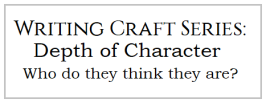Depth is a vast word, a sea of information created of layers. It is complex, intense, and profound. Characters with depth feel solid, alive, as real as your best friend.
 To achieve a sense of depth, we begin with simplicity. Each character’s sub-story must be built upon who these characters think they are.
To achieve a sense of depth, we begin with simplicity. Each character’s sub-story must be built upon who these characters think they are.
One of the most useful seminars I’ve ever attended was given by a Romance writer. He is a strong proponent of assigning verbs and nouns to each character at the outset as a way to get inside their heads.
If there is one thing Romance authors understand, it is how to create a strong impression of character.
When I plan a character, I make a simple word picture of them. The word picture is made of a verb and a noun, the two words that best describe each person. We want to know the good things about these characters, so we assign nouns that tell us how they see themselves at the story’s outset.
We also look at sub-nouns and synonyms, so put your thesaurus to work. In my book, Julian Lackland, I had four characters with significant roles, so I assigned them nouns that describe their principal defining quality.
This noun is the core characteristic thread that stays with them, is challenged by events, and either wins in the end or is their downfall.
Julian’s Noun is: Chivalry (Gallantry, Bravery, Daring, Courtliness, Valor, Love.) He sees himself as a good knight, a defender of innocence.
Beau’s Noun is: Bravery (Courage, Loyalty, Daring, Gallantry, Passion.) He aspires to chivalry but has a pragmatic side. He sees himself as a good knight but knows that good doesn’t always win.
Lady Mags’s Noun is: Audacity (Daring, Courage.) She is a good knight but is under no illusions about the people she defends. She is chivalrous but practical.
Bold Lora’s Noun is: Bravado (Boldness, Brashness.) She desires fame, is convinced that knights are defined by the celebrity their deeds bring them.
In real life, the way we see ourselves is the face we present to the world. Self-conceptions color how we react to events. We are gradually altered by events as life goes on. Our view of ourselves evolves, and our reactions are changed.
By the end of the story, the way our characters see themselves should have evolved. The circumstances you put them through must affect and remake them.
Once I know their nouns, I assign my characters a verb that describes their gut reactions. This word will shape the way they react to every situation that arises.
 They might think one thing about themselves, but this verb is the truth.
They might think one thing about themselves, but this verb is the truth.
Julian has 2 Verbs. They are: Defend, Fight. Again, we also look at sub-verbs and synonyms: (Preserve, Uphold, Protect.)
Beau’s 2 Verbs are: Protect, Fight (Defend, Shield, Combat, Dare.)
Lady Mags’s 2 Verbs are: Fight, Defy (Compete, Combat, Resist.)
Bold Lora’s 2 Verbs are: Desire, Acquire (Own, Control, Imprison.)
When I wrote these characters, I knew how they believed they would react in a given situation and that knowledge drove the plot. Why was it so clear to me? Because I had drawn their portraits in a few descriptive words.
Julian must Fight for and Defend Chivalry. Julian’s commitment to defending innocents against inhumanity breaks his mind.
Beau must Fight for and Protect Bravery. Beau’s commitment to protecting Julian and concealing his madness breaks his health.
Lady Mags must Fight for and Defy Audacity. She’s at war with herself regarding her desire for a life with Julian and Beau. That war ruins her chance at happiness.
Bold Lora must Acquire Fame and Control Chivalry. Her thirst for notoriety destroys her.
When we uncover the nouns and verbs that describe who our characters think they are, we have a grip on creating characters who are alive to the reader.
How we phrase this when describing them in our outline is essential. Placing the verb before the noun describes a character’s core conflict. It lays bare their flaws and opens the way to building new strengths.
Knowing who our characters are before we meet them is important. Go ahead and make that personnel file detailing their backstory if you need to. Set that infodump aside because the real story will be built upon who they think they are on page one of this story.
Our characters’ preconceptions color their experience of events, which colors the readers’ view.
The characters we write are unreliable witnesses to the events that shape them. Their self-perception shades their reactions when they fail to live up to their own standards.
These are the watershed moments when our characters must examine their motives, and either face them or gloss over their failings.
Depth is instilled into to a scene where the characters prevail despite their flaws, succeeding against the odds. Or conversely, depth can be added when character flaws cause them to fail miserably at a point where they could have triumphed.
What two words describe the primary weaknesses of your characters, the factor that could be their ultimate ruin?
Julian Lackland: Obsession and Honor.
Beau Baker: Steadfast Loyalty.
Lady Mags De Leon: Stubbornness and Fear (of Entrapment).
 Knowing the verb (action word) and the noun (object of the action) that best represented my characters made writing Julian Lackland easier. Their actions and reactions unfolded, and it was as if the story wrote itself.
Knowing the verb (action word) and the noun (object of the action) that best represented my characters made writing Julian Lackland easier. Their actions and reactions unfolded, and it was as if the story wrote itself.
So how do we get to know our characters and how they see themselves? Just as in real life, we meet and come to know them through conversations.
Conversations give shape to the story, turning what could be a wall of words into something personal.
Our next installment in this series will focus on revealing character through conversations.








This was a really interesting post. I’m currently teaching myself how to outline, and the books I’ve been consulting all suggest starting with one’s protagonist. This is an nice, different way of approaching the topic.
LikeLiked by 1 person
Hello! I’m glad you found something useful here!
LikeLike
This was a great post! I’m trying to reacquaint myself with my characters, who I’ve been with so long that sometimes I forget who they are. It’ll be helpful to have them reintroduce themselves to me with this exercise. Thanks!
LikeLiked by 1 person
Hello! Thank you for your kind words! I’m glad you found something of use here. ❤
LikeLiked by 1 person
Reblogged this on Chris The Story Reading Ape's Blog.
LikeLiked by 1 person
😀 Thank you for the reblog, Chris! You made my Monday! ❤
LikeLiked by 1 person
My pleasure, Connie 🤗❤️🤗
LikeLike
Pingback: Fundamentals of Writing: Conveying Depth and Revealing Character through Conversations #amwriting | Life in the Realm of Fantasy
Pingback: Fundamentals of Writing: Character Depth – who do they think they are? #amwriting – Written By Connie J. Jasperson – Writer's Treasure Chest
This is a brilliant post. I will be using this method in the future to get to know my characters better. Thank you so much for posting it.
Reblogged on Dragons Rule OK.
LikeLike
Thank you for you kind words, and for the reblog!
LikeLike
Pingback: creating character depth | Dragons Rule OK. V.M.Sang (author)
Thank you, Connie this is a brilliant way if bringing characters to life and so well explained for a novice like me…Thank you 🙂
LikeLiked by 1 person
Hello! I’m glad you found something you could use! And don’t fret about being a novice–we all begin somewhere. I went fulltime at the age of 55, so it’s been a learning curve for me too!
LikeLiked by 1 person
Thank you for the insightful blog on characterization. I am trying to improve my writing and will use this method to help me
LikeLiked by 1 person
Hello and welcome! I’m glad you found something useful here!
LikeLike
What a great tool for working on characterization. I’ll have to try this exercise for the characters in my WIP.
This also reminded me of Fallen London, the literary browser game where hardly any of the characters you encounter have proper names. Instead, everyone has an adjective-noun moniker. You’d think this would be limiting, but the names are so distinctive that it works: the Ambitious Barrister, the Captivating Princess, the Jovial Contrarian, or the Gracious Widow.
It’s amazing, the amount of character that can come out of a few well-chosen words!
LikeLike